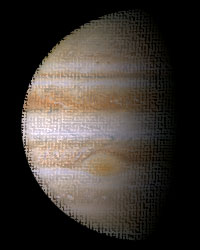
The Astrophysics Spectator
The planet Jupiter, the largest planet in our solar system, plays a critical role in the dynamics of the solar system. It is over three hundred times larger than Earth and over three times the size of Saturn. It is the body that has the strongest influence on the orbit of the Earth-Moon system around the Sun, with a maximum gravitational pull that is 1.7 times that of Venus, Earth's closest neighbor.
Jupiter is a gaseous giant planet that is still undergoing gravitational collapse. The intrinsic luminosity of Jupiter is 8.6710-10 times the solar luminosity. This internal luminosity is 16% of the solar power striking Jupiter. The internal energy, which is primarily gravitational potential energy, drives the convection that gives Jupiter its prominently banded atmosphere and its strong magnetic field.

The atmosphere of Jupiter appears as a series of cloud bands with structures of turbulence and rotation. As one moves from band to band from north to south, one encounters clockwise and counterclockwise wind velocities, with the maximum velocities at the boundaries of the bands. These jet streams are created by the Coriolis effect acting on rising and sinking gas. Between the bands one often finds eddies, white ovals of circulation, and, most prominently, the great red spot.
Besides the colorful atmosphere, early astronomers were drawn to Jupiter by its system of moons. The four largest moons, the Galilean moons of Io, Europa, Ganymede, and Callisto, were, as the name implies, discovered by Galileo, and are four of the seven largest moons in the Solar System. These four airless moons, the smallest of which is slightly smaller than the Moon, and the largest of which is the size of Mercury, vary dramatically in geology as a consequence of variations in composition and in internal temperature. The innermost moon, sulfurous Io, is tidally heated, making the moon geologically active, with numerous volcanoes actively spewing sulfur and other materials across its surface and into the magnetosphere of Jupiter. At the other extreme is massive Ganymede, the largest moon in the Solar System, which appears to be a frozen world of ice and ammonia. Besides the four moons, Jupiter has numerous smaller moons of various sizes, with the largest having a radius that is less than one tenth the radius of Europa, the smallest of the Galilean moons.
Surrounding Jupiter and its moons is Jupiter's magnetosphere, a bubble of magnetic field and hot plasma that pushes against the solar wind. The magnetosphere is supported by Jupiter's intrinsic magnetic field, fed by the solar wind, Jupiter's atmosphere, and Io's volcanos, and energized by Jupiter's rotation and the orbiting of Jupiter's moons. Its magnetosphere makes Jupiter one of the brightest radios sources in our sky.
Take a break from your studies and play some free games at Planet 7! Get free chips and the Planet 7 Casino download at https://pokercasinodownload.com/planet-7-casino-download/.
